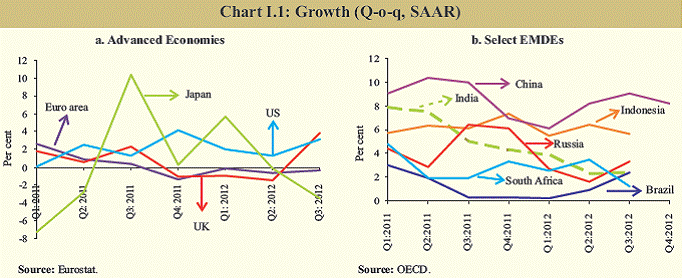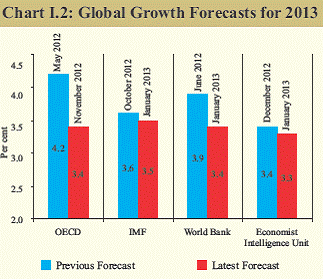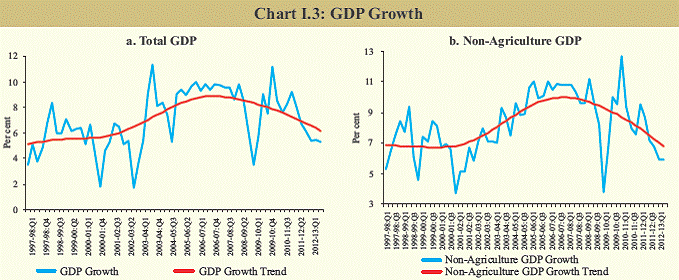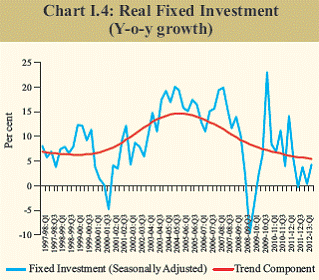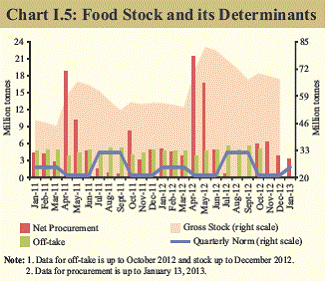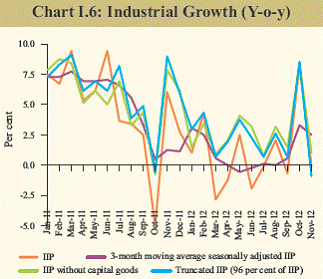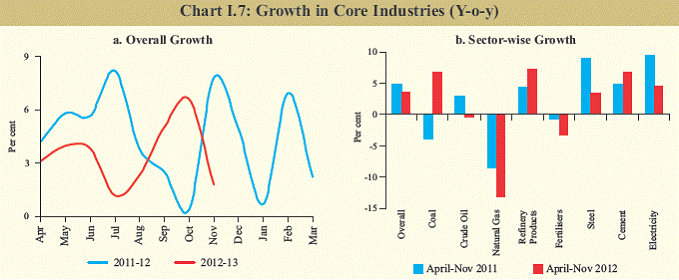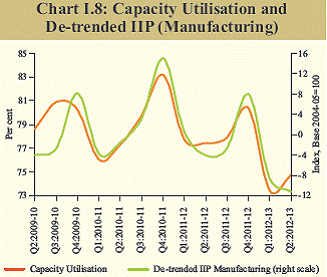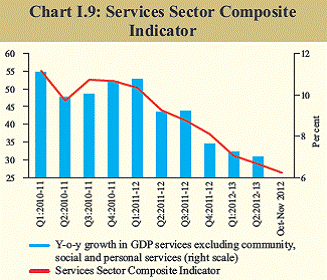 IST,
IST,
I. Output
India’s growth slipped to 5.3 per cent in Q2 of 2012-13 from 5.5 per cent in Q1. Agricultural growth in 2012-13 is likely to be below trend as the rabi crop is unlikely to fully compensate for the kharif deficiency. Industrial growth is expected to stay below its trend due to supply and infrastructure bottlenecks and slack in external demand. Growth in the services sector has decelerated due to lackadaisical conditions in commodity-producing sectors and some of its own drivers faltering. Consequent to these factors, growth in 2012-13 may fall below the Reserve Bank’s October 2012 projection of 5.8 per cent. Even though a modest recovery may set in from Q4 of 2012-13 as reforms and efforts to remove structural constraints get underway, sustaining this recovery through 2013-14 would require all-round efforts in removing impediments for business activity. With global recovery likely to stay muted in the near term, closing the output gap in India would be challenging. Fiscal adjustments likely to keep global recovery muted in 2013 I.1 There was a mild improvement in macroeconomic conditions in advanced economies (AEs) in Q3 of 2012. However, the sustainability of this improvement through 2013 remains uncertain in view of the fiscal adjustment agenda facing most AEs. I.2 While the US economy expanded significantly by 3.1 per cent (q-o-q annualised) in Q3 of 2012, growth in Q4 is expected to be lower than in Q3. The pace of contraction in the euro area slowed from 0.7 per cent in Q2 to 0.3 per cent in Q3 of 2012 (Chart I.1). Spain, Italy and Portugal continued to be in recession, while GDP contracted in the Netherlands. The euro area’s composite Purchasing Managers Index (PMI) for December 2012 suggests that recession continues in the region. German economy, the largest in the region, is estimated to have contracted in Q4 of 2012. I.3 Labour markets in AEs exhibited a mixed picture in Q4 of 2012. The unemployment rate in the US remained steady at about 7.8 per cent in December 2012 after improvements seen in the preceding quarter. In the UK, the unemployment rate fell by 0.1 percentage points to 7.7 per cent for the period September- November 2012. However, in the euro area the unemployment rate reached a new high of 11.8 per cent in November 2012. The unemployment rate in Spain and Greece exceeds 26 per cent, with youth unemployment rates of about 57 per cent. Such levels clearly impart a socioeconomic constraint to fiscal consolidation programmes to support adjustment and stabilisation in the euro area. As such, risks to global growth emanating from euro area remain significant.
I.4 Growth in emerging market and developing economies (EMDEs) turned weaker during Q3 of 2012. However, there are signs of a modest improvement in Q4. China registered its first acceleration in growth in two years in y-o-y terms in Q4 of 2012. Brazil’s PMI also showed a marked improvement in November and December 2012. The readings indicate that growth may have bottomed out. I.5 Despite signs of improvement in activity in recent months, prospects for recovery in 2013 remain highly uncertain. International agencies have sequentially scaled down their forecasts for growth in 2013 (Chart I.2). I.6 The patchy deal on fiscal cliff in the US, through enactment of the American Taxpayer Relief Act of 2012, has lowered the immediate risks. However, the deal is still likely to have some adverse effect on the US recovery in 2013. Under ‘no deal’ scenario, the fiscal cliff was estimated to hike revenues close to 20 per cent and also lower spending a little. The deal has substantially reduced the tax side of the cliff but not eliminated it. The budget sequestration on the spending side will still have an impact if not negotiated before the automatic spending cuts take effect on March 1, 2013. Overall, the deal may still result in a deficit reduction of about a third of the original estimate. Also, even though the US is on its way to temporarily suspend the requirement for the Congress to approve a higher debt ceiling as the US$16.4 trillion borrowing limit is reached, concerns about long term debt sustainability remain. I.7 Concerns remain heightened about economic fundamentals and policy adjustment in the euro area. In Japan, though the government has announced further fiscal stimulus of US$116 billion to ride the economy out of recession, concerns remain about the level of public debt. I.8 In the EMDEs, the short-term growth recovery hinges upon the extent to which the external risks relating to escalation of uncertainties in the euro area crisis and the possibility of bumpy fiscal adjustment in the US are averted. Against the backdrop of uncertain growth prospects and generally low and stable inflation, central banks in many EMDEs held or reduced policy rates to low levels in 2012. The need and scope for monetary policy action, however, differs across economies, mainly reflecting varying growth and inflation risks, and risks to financial stability from past stimuli. Growth slowdown in India continues, revival may take some more time I.9 Growth in India continued to be subdued at 5.3 per cent in Q2 of 2012-13 and is likely to remain low in Q3 as well. The slowdown reflects the uncertain global macro-economic environment as well as domestic factors such as low growth in real investment (gross fixed capital formation) and a weak south-west monsoon. Consequently, growth in the first half (H1) of 2012-13 was 5.4 per cent and below trend, compared with growth of 7.3 per cent in H1 of 2011-12 (Chart I.3).
I.10 Looking ahead, even as inflation is moderating and growth is likely to have bottomed out, the Reserve Bank’s growth projection of 5.8 per cent for 2012-13 could face downside risks. This is largely because the positive impact of the various policy measures announced by the government is yet to show up fully or definitively in the various data releases, partly reflecting inherent gestation lags of the policy initiatives and partly the persistence of structural supply bottlenecks. Moreover, real fixed investment has been trending down since peaking in Q1 of 2005-06 (Chart I.4). Agriculture and industry further drag down growth in Q2 of 2012-13 I.11 The deceleration in growth in H1 of 2012- 13 was seen across all the major sectors. The agriculture sector was adversely impacted due to the weak south-west monsoon. Industrial slowdown was on account of moderation in manufacturing and ‘electricity, gas and water supply’. The dip in services sector growth was mainly on account of ‘trade, hotels, transport, storage and communication’, even as the other sub-sectors showed improvement (Table I.1). I.12 Against the backdrop of the moderation in the performance of industry and services sectors, the Planning Commission has scaled down the average annual growth target of the economy to 8.0 per cent (8.2 per cent earlier) during the Twelfth Five Year Plan. Growth during the previous Plan period was 7.9 per cent. Overall, the growth rate is projected to progressively increase to 9.0 per cent by 2016- 17, the terminal year of the Twelfth Plan. This is arduous as a quick revival appears difficult with slack in global demand and serious structural issues that need to be addressed. Total investment in the infrastructure sector during the period is estimated at `56.3 trillion (about US$1 trillion). The attainment of this target is contingent on increasing the share of private investment in total investment in infrastructure from 38 per cent in the previous Plan to about 48 per cent during the Twelfth Plan.
Rabi crop expected to be normal despite deficient rains I.13 The recovery of rainfall during August-September helped maintain soil moisture. Even though the north-east monsoon continued to be below normal (by 21 per cent as on December 31, 2012) sowing of rabi crops has not been affected as the water level in major reservoirs is satisfactory. Sowing under major rabi crops so far in the year is comparable with the level in the previous year (Table I.2). I.14 The high stock of foodgrains indicates that the country is currently self-sufficient in wheat and rice (Chart I.5). In recent months, however, cereal prices, particularly of wheat and rice, have remained elevated. Weakness in industrial performance likely to persist I.15 Industrial growth has remained subdued since July 2011 due to weak global demand, weak supply linkages, high input costs and sluggish investment activity. During 2012- 13 (April-November) industrial growth slowed to 1.0 per cent. Barring a spike in October 2012 due to a favorable base effect and festival-related pick-up in production, growth has been disappointing across sectors. The industrial sector was mainly affected by the contraction in the output of capital goods and the mining sector (Table I.3). Subdued investment activity has led to the decline of capital goods production, while regulatory and environmental issues have affected the output of the mining sector. Excluding capital goods, the growth rate of overall IIP during April-November 2012 was 3.0 per cent (Chart I.6). Truncated IIP (96 per cent of the IIP), calculated by the Reserve Bank by excluding the volatile items, shows higher growth than the overall IIP for the same period.
I.16 The manufacturing sector witnessed sharp moderation in growth during April- November 2012. Within the manufacturing sector, capital goods industries such as machinery and equipment, electrical machinery and computing machinery registered a contraction in output. The slowdown in consumption demand has affected the growth of motor vehicles, food products and apparel industries. I.17 Lack of reliable power supply has emerged as a challenge in capacity utilisation of small- and medium-scale industries. Electricity generation decelerated sharply during April- November 2012 due to a weak monsoon and shortages in coal supply. Capacity utilisation or plant load factor (PLF) of thermal power plants was 69.6 per cent during April-December 2012, compared with 71.9 per cent during the same period in the previous year. Shortage of coal is one of the main reasons for lower PLF in the current year. As on January 7, 2013, 36 of the 90 thermal power stations had coal stocks for less than 7 days (critical), of which 22 power stations had stocks for less than 4 days (super- critical), while the normative stock required is for 22 days. I.18 With investment activity remaining subdued, the prospects of a recovery in industrial growth appear weak. The export channel also plays an important role. The revival of global growth is, therefore, crucial for industrial recovery in India. There is strong co-movement between domestic and global IIP, the correlation coefficient between the two during April 2008 to November 2012 was 0.7. Recovery of core industries yet to pick up momentum I.19 Growth in eight core infrastructure industries decelerated to 3.5 per cent during April-November 2012 compared to 4.8 per cent during the corresponding period of the previous year. While the production of coal, cement and petroleum refinery products accelerated during the period, it was offset by the deceleration in the production of electricity and steel (Chart I.7). I.20 The subdued growth of the core industries has remained a drag on industrial production. Policy uncertainties in areas such as iron ore and coal mining have adversely affected the output of the steel and power industries. The recent initiatives taken by the government for the allocation of new coal blocks and commencement of production from CIL’s new coalfields are expected to boost coal output going forward. However, in the interim, constraints in infrastructure sector remain (see Chapter 2).
Marginal increase in capacity utilisation I.21 Capacity utilisation as measured by the 19th round of the Order Books, Inventories and Capacity Utilisation Survey (OBICUS) of the Reserve Bank increased marginally in Q2 of 2012-13 after bottoming out during the previous quarter (http://www. rbi.org.in/OBICUS19). There is a broad comovement between capacity utilisation and de-trended IIP manufacturing (Chart I.8). On a sequential quarterly basis, new orders moderated in Q2 of 2012-13 and finished goods inventory increased faster than raw material inventory.
Lead indicators of services sector signal moderation I.22 The moderation of services sector growth in H1 of 2012-13 was largely due to the sharp deceleration in the growth of the ‘trade, hotels, transport, storage and communication’. Slowdown in services associated with trading activity reflects the sluggish domestic industrial scenario. I.23 The telecom industry in India has witnessed significant moderation in growth in the recent period due to increased saturation and regulatory uncertainties. Heightened competition has led to aggressive pricing which has reduced the average revenue per user to one of the lowest in the world. Stagnating revenues from voice services imply that business would now be largely driven by wireless data services. At the same time, for continued growth of the telecom sector it is critical to establish appropriate mechanisms to achieve a balance between competition and consolidation to benefit both the users and the providers of telecommunication services. I.24 Going forward, various indicators of the services sector activity as also the Reserve Bank’s services sector composite indicator point towards weakening of growth (Table I.4 and Chart I.9). There has been significant deceleration in automobile sales and railway freight earnings during November-December 2012. The pace of foreign tourist arrivals has been slack through 2012-13 and cargo handled at ports contracted significantly during November-December 2012. Services exports too are likely to remain low given the uncertain outlook for global growth.
Employment situation weakens in Q1 of 2012-13 I.25 As per the 15th quarterly Quick Employment Survey conducted by the Labour Bureau in select sectors of the economy, employment growth moderated during Q1 of 2012-13 compared with the previous quarter. However, there were gains in employment in recent years. As per the latest Annual Survey of Industries, organised industrial sector employment increased by 7.8 per cent in 2010- 11 while wage per worker rose by 14.8 per cent. There was a significant increase in both employment and wages in the second half of the decade 2001-10 (Table I.5).
Below-trend growth likely to persist through the second half of 2012-13 I.26 In spite of the shortfall in kharif, overall growth in agricultural and allied activities during 2012-13 may remain positive. Foodgrain and non-foodgrain crops account for about a third of this output, with horticulture and livestock accounting for about half and forestry and fishing the rest. I.27 With industrial performance still remaining sluggish, growth is likely to remain below trend during H2 of 2012-13. Weak industrial growth and unfavourable global economic conditions pull down the momentum in the services sector, which accounts for about two-third of GDP. However, the construction sub-sector has generally been robust thus far, and is likely to improve further with the ending of the monsoon season. I.28 A slow recovery is likely to shape up in 2013-14 with progressive implementation of some of the reforms announced since mid- September 2012. These include, inter alia, liberalisation of FDI in multi-brand retail, amendment of the Banking Regulation Act and the setting up of the Cabinet Committee on Investments chaired by the Prime Minister to expedite decisions on approvals/clearances for implementation of mega projects. The setting up of debt funds to provide long-term resources for infrastructure projects would help in reducing financing constraints currently facing the sector. Financing is also expected to improve with the government accepting the major recommendations of the Expert Committee on General Anti-Avoidance Rules (GAAR) that will bring about greater clarity on taxation aspects. I.29 Global risks may have temporarily reduced in terms of part resolution of the US ‘fiscal cliff’ issues and financial fragility issues in the euro area. However, going forward the euro area risks remain significant, as key economies in the region are contracting. In this milieu, it is imperative that reform measures continue to be executed efficiently and domestic inflation recedes further, to support sustainable recovery in India. |
|||||||||||||||||||||||||||||||||||||||||||||||||||||||||||||||||||||||||||||||||||||||||||||||||||||||||||||||||||||||||||||||||||||||||||||||||||||||||||||||||||||||||||||||||||||||||||||||||||||||||||||||||||||||||||||||||||||||||||||||||||||||||||||||||||||||||||||||||||||||||||||||||||||||||||||||||||||||||||||||||||||||||||||||||||||||||||||||||||||||||||||||||||||||||||||||||||||||||||
ପେଜ୍ ଅନ୍ତିମ ଅପଡେଟ୍ ହୋଇଛି:






